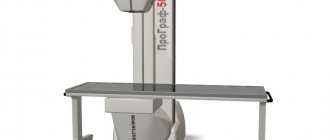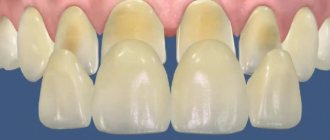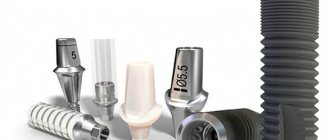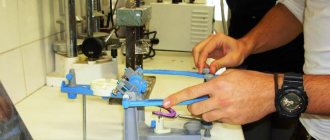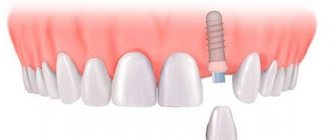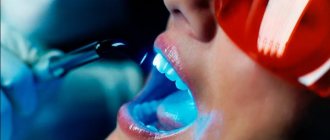Description of the procedure
Tooth preparation is the removal of hard tissues that are damaged or interfere with the fixation of the crown.
Previously, turning under metal ceramics was long and painful. However, thanks to modern anesthesia drugs and the latest instruments, the duration and pain are significantly reduced.
During the procedure, the doctor strives to preserve healthy organs as much as possible. In this case, it is necessary to create natural forms, which is achieved through the formation of ledges.
For proper preparation, the following criteria must be met:
- the dental organ has retained its natural shape;
- the tooth stump is reduced and slightly tilted;
- the tooth is reduced in size by up to 2 mm;
- There are no unpleasant consequences near the dental organ.
Thanks to the preparation of teeth, the metal-ceramic crown receives the place it needs, so that it does not exceed the neighboring teeth in height and does not protrude outward or inward.
The crown should fit tightly under the gum, which is facilitated by a ledge under the gum.
To install a solid crown, up to 0.3 millimeters must be removed from the lateral surface without damaging adjacent teeth. To install a metal-ceramic prosthesis, the tooth is depulped and then 2 millimeters are removed from it. There should be a ledge on each side.
The doctor determines what size layer to remove based on the size of the tooth and the characteristics of its position in the dentition.
We ground my teeth for crowns and they hurt
Use the search on the site:
This can be caused by trauma to the periodontal tissues or a poorly fitting crown. You should contact the doctor who treated your teeth; the situation requires correction.
It makes sense to endure if the pain gradually subsides. If not, or on the contrary, it will increase, then you need to go to the doctor.
Unfortunately, this is unlikely to go away if it has been going on for a whole month. Actually, ceramic crowns for living teeth, i.e. teeth in which the neurovascular bundle has not been removed are usually not placed due to the high risk of complications. I'm afraid you will have to remove the bridge and depulp the tooth.
If it turns out that the tooth needs to be opened, then the prosthesis will have to be removed and a new one made. In this case, you will have to pay for it, of course.
You need to see a dentist, you need treatment.
In advance, Thanks for your answer!
The doctor will make a decision about the need to remove the prosthesis after an x-ray, but I’m afraid this will most likely be necessary.
If the pain does not go away, you definitely need to see a doctor. This is most likely periodontitis, an inflammation of the ligamentous apparatus of the tooth; it requires treatment, and in its absence can cause complications. Therefore, do not delay your visit to the doctor.
The cause of persistent pain may be trigeminal neuralgia.
Yes, the nerve needs to be removed.
Anastasia, you need to see a dentist and take a picture of the tooth, the symptoms are similar to periodontitis. If it is confirmed, then the entire prosthesis will need to be removed.
We ground a living tooth for a crown. They installed a temporary plastic one. The tooth hurt for several weeks. About once a day in the evening or at night, when she clenched her teeth during sleep. The reaction was to cold and hot, it passed quickly. At night it didn’t hurt as much and didn’t go away as quickly. Please advise what to do, depulp the tooth and fill the canals, or leave it as is, put a crown and wait, and fill the canals under the crown in a hundred years?
Good afternoon, Anna.
Good afternoon, Anna.
Thank you very much for your answer! Tell me, if the pin goes beyond the limits, is this the doctor’s illiteracy? After all, I didn’t even bite on the tooth.
This question can only be answered after an examination by a dentist and x-rays. First you need to find out. what's wrong with the tooth?
Worth worrying. Go to the doctor if the pain does not go away on the third day, and insist that the teeth be depulped before the final fixation of the dentures.
No, the root of the tooth cannot cause your leg to hurt.
Rinsing with chamomile or salt water will not help. You need to see a dentist.
Source: med-sovety.ru
Peculiarities
Grinding teeth for metal ceramics has the following features:
- The need to remove a significant layer of enamel and dentin (up to 2 millimeters).
- The use of anesthesia so that the patient does not feel pain during grinding. The most common methods are infiltration and conduction anesthesia.
- The main goal of specialists is to preserve as much bone tissue as possible and remove all damaged areas.
- After removing the tissue, a truncated cone is obtained, the edges of which are then slightly rounded.
- Grinding should be done intermittently after every 2-3 seconds.
- The tool must be constantly cooled during grinding so as not to cause a burn to the pulp.
- The contact surfaces must be ground with the device at low speeds.
Causes of pain after turning
The preparation of teeth for metal-ceramics takes place under local anesthesia, so it is completely painless. But after the anesthesia effect ends, pain may occur in the gum or ground tooth under the crown. If they are present for several days after turning, the causes of pain may be as follows:
- the body’s reaction to nerve removal and dental canal filling;
- opening the tooth cavity during the grinding process;
- irritation of the pulp, manifested by vasodilation and the formation of edema;
- compression of soft tissues during gum retraction with subsequent swelling and pain.
Such side effects are reversible, are considered normal and go away on their own without medical intervention after 3-7 days. To alleviate the condition, you can take painkillers recommended by your dentist.
When pain does not go away for a long time or occurs and increases after some time under an installed crown, its causes may be the following:
- poor-quality cleaning and filling of root canals, which creates conditions for the spread of infection and the occurrence of periodontitis;
- inflammatory process in the gums due to injury to tooth tissue during turning under metal-ceramics;
- rotting of a pulpless tooth due to perforation of the root canal, formation of a fistula in the gum;
- too thin a layer of preserved dentin above the unremoved pulp, which is why the tooth begins to react to cold and touch;
- periodontal abscess - a focus of inflammation at the apex of the root canal with accumulation of pus under the crown;
- suppuration due to poor installation of the pin;
- overheating of the dental nerve with pulp burn due to poor cooling of the prepared teeth, dull or poor-quality instruments, haste and carelessness of the doctor, which subsequently causes the development of pulpitis under the crown.
- allergy to prosthesis material, cement, foreign body in the oral cavity;
In all these cases, an immediate visit to the dentist who carried out the grinding and installation of metal-ceramic teeth is required to find out the exact cause of the pain, prescribe medication or perform surgical intervention if necessary.
Poorly performed work by a doctor requires the removal of the crown and elimination of deficiencies, redoing, and this is a labor-intensive and unpleasant process. Therefore, to install metal-ceramics, it is very important to choose a clinic with modern high-quality equipment, experienced qualified personnel, and guarantees for dental services.
| Cavities are no longer a problem! Do you have caries, but are you afraid to go to the dentist? You can cure it at home! Read more >>> |
| How I whitened my teeth in a short time After 1 week, my teeth became SNOW-WHITE! I just did... Find out more >>> |
| The best remedy for getting rid of headaches Vladimir Pozner: “Because of terrible headaches, my career on TV hung by a thread” Read more >>> |
Your mark:
(votes: 1 , average: 10.00 out of 10)
Stages of the procedure
Let's take a step-by-step look at how teeth are ground for a metal-ceramic crown:
- Creating grooves. The doctor makes peculiar incisions that will show how much hard tissue needs to be removed. These grooves subsequently contribute to uniform grinding. Creation of notches can be done with a bur or a shaped head in the form of a wheel. They are carried out from the vestibular side to a depth of 1.5 millimeters. The ledges on the palatal and vestibular sides are removed.
- Removing tissue from the vestibular and oral sides. Maximum caution is important at this stage. Diamond burs directed parallel to the tooth remove the required layer. When working on the palatal side, the palatal tubercle is preserved.
- Preparation from the occlusal surface. This stage consists of preparing one and a half to two millimeters, while not disturbing the anatomy of the chewing surface. The living crown of the anterior dental units is thus shortened by 25%.
- Separation of the contact side. It is important to separate the medial surface from the distal one and then remove the tissue. A diamond bur with flame-shaped or needle heads is used. 0.5 millimeters are left above the gum. To prevent periodontal injury, a dental matrix and an interdental wedge are used.
- Gum retraction. If it is necessary to immerse the bur deeply, you need to protect the gums. Therefore, it is moved away with the help of special threads, rubber rings and a spatula. This stage is important for taking an impression so that a high-quality model can be easily made.
- Formation of the ledge. The width of the ledge can be 0.5-1.5 millimeters, depending on the anatomy of the dental organ. It is made with a face bur.
- The final stage of processing. The dental stump should be in the form of a uniform cone. At this stage, irregularities are cut off, protruding edges are removed, and the stump is rounded.
Tooth preparation: how to grind for inlays?
Teeth preparation or grinding is an essential element of any prosthetics. Without this, it is impossible to place a crown on a jaw segment. Many patients who are installing such systems for the first time are very afraid of grinding. Let's try to answer the questions: how are teeth ground for crowns and is it painful to grind teeth?
Grinding chewing elements for crowns: stages of the process
Grinding of teeth for crowns should not be confused with preparation for inlays. A ceramic inlay never involves depulpation, i.e. deprivation of the nerve, whereas during prosthetics the nerve is removed in most cases. The grinding of hard tissues under the inlays is minimal, since the inlay is an improved analogue of a filling. Preparing teeth involves serious work with the oral cavity.
Grinding occurs using a special tool - a bur. Usually, if a particular segment of the jaw is not deprived of a nerve, anesthesia is used. If depulpation is performed, then dentists do not use anesthetics. Many patients complain that after grinding their teeth hurt or their gums become inflamed. In most cases, these are temporary phenomena that disappear after a couple of days. However, the possibility of injury to the cavity cannot be ruled out.
Each type of prosthetics has its own specifics for turning teeth for crowns:
- When fixing a metal-free ceramic system, hard tissue is removed by one or two millimeters. In this case, depulpation is not performed.
- When prosthetizing a metal-ceramic device, the chewing elements are usually depulped, and hard tissues are ground down to three millimeters.
Purposes of preparation
Removing hard tissue
Teeth preparation always occurs with a ledge, which is created at the edge of a certain segment of the jaw row. It usually forms just above the gum. What is it for? Based on its impression, the dental technician forms the optimal size of the structure, which is rarely longer than necessary. And yet, even the best prosthetist is not able to create an ideal structure because the jaw element is rarely of an exclusively correct shape. Moreover, it is almost impossible to form a prosthesis that fits perfectly to the stump.
Dentists identify the following purposes for grinding teeth down for crowns:
- When turning, part of the jaw acquires the shape necessary to fix the prosthesis.
- When grinding teeth for crowns occurs, all carious hard tissues are removed. If the prosthesis fits well, a certain segment of the jaw row will not be affected by caries a second time.
An important question is whether a ledge is needed in principle? Recent studies by famous prosthetists confirm that it is necessary in any case. However, Russian dentists do not always create it. And here are the reasons:
- the time for preparing teeth without a ledge is reduced;
- Only a very competent specialist can create a good ledge. Most Russian dentists working in the provinces are accustomed to dealing with metal or even stamped equipment. They do not imply the presence of a ledge;
- the price of materials for forming impressions of ledges is high and not every clinic can afford them.
The consequences of fixing crowns without a ledge are not the best. Even with professional and precise processing of hard tissues of individual segments of the jaw row, a design without a ledge will lead to rotting and destruction of the chewing element and gum atrophy.
Which ledge to use?
Turning with shoulder
There are several options for ledges. The first one is grooved. It is suitable for metal ceramics. Its width is a little less or a little more than a millimeter (0.8 1.2 mm). The second is a knife-shaped one, which is used for prosthetics of solid crowns. The width is from a third to a quarter of a millimeter. The third option is the shoulder one. Its maximum width is up to two millimeters. This type of ledge always requires depulpation. Despite all the inefficiency, it has a significant advantage - it ensures maximum fit of the structure to the stump.
Complications
Note: Grinding teeth for crowns is sometimes a risky process, especially if the prosthetics are not carried out by the best specialist and we are talking about preparing teeth for solid or metal structures.
Thus, experts in this field identify several types of injuries that occur after grinding:
- Poor preparation of teeth for metal-ceramics can cause destruction of the gingival margin. As a result, the patient's gums begin to become inflamed and then atrophy. Some dentists suggest introducing substances during prosthetics that prevent the occurrence of inflammatory processes. Another option is to use a low-level laser. It stabilizes microcirculation, reduces the risk of inflammatory and edematous processes.
- If after grinding your teeth hurt, and the pain does not go away even after several days, then this is the surest sign of gingivitis - an inflammatory process, again, in the gum tissue. The main cause of the disease is gum trauma during crown grinding. If the gum tissue is damaged, then food debris and bacteria will penetrate under the denture, leading to periodontitis.
Any gum injuries are treated with antiseptics, if the complication after prosthetics is not so dangerous. If the complications are serious, you will have to remove the device and fix it again.
Laser processing
Thanks to laser pulses, a thermal effect occurs on the fluids contained in the teeth. In this case, the structure of the material is microscopically destroyed. Unnecessary tissue is then cooled with an aqueous solution or air, and then removed without hindrance.
Laser preparation has the following advantages:
- no noise when the tool operates;
- safety of the procedure due to the absence of tips in the device that rotate at high speed;
- the frame for the future crown is obtained quickly and without pain;
- infection during the procedure is excluded, since the instrument does not touch the tissues.
Dissection in children: features
Performing this procedure in children is not an easy task. It is complicated by fear in young patients of dental office equipment, especially the sight of a drill and even its sound during operation. The structure of baby teeth is anatomically different from permanent teeth - this does not make it possible to carry out such manipulations with them. Dentists are looking for other methods of treating baby teeth with caries.
Children can have their teeth prepared only to treat any pathologies.
The chemical method is one such method. The procedure itself does not cause fear or other unpleasant sensations in children. Therefore, the doctor can focus on the procedure itself, and not on persuading small patients.
Interesting! In addition, chemical preparations make it possible to treat the cavity of a tooth affected by caries quite efficiently.
Tunnel preparation
Tunnel turning is carried out using turbine units with diamond or metal tips. At the same time, it is important that the equipment is new, since a worn-out instrument can cause overheating of the tissues and their destruction.
Note: With this method, it is possible to save as much material as possible for future crown installation. The result of removal can be predicted in advance, and during the procedure it is easy to control the volume of the removed layer.
This type of preparation is used today more often than other methods.
Preparation with abrasives
An alternative to a drill with its rotating drills is also the supply under pressure of air mixtures containing an abrasive powdery substance. By acting on the enamel, this mixture gradually removes hard tooth tissue.
Features of preparation with abrasives are as follows:
- speed of the procedure;
- absence of tissue overheating and painful sensations;
- gentle effect on the dental shell;
- careful grinding, which allows you to obtain the necessary stump while preserving a significant amount of healthy tissue.
Modern preparation techniques
Today, there are various methods of grinding teeth before prosthetics.
Ultrasonic preparation
Ultrasound equipment allows the preparation procedure to be carried out quickly and without any complications. Ultrasound simplifies the procedure and eliminates the need to use hemostatic agents. This method is especially relevant if the thickness of the enamel is very small.
Often teeth are prepared with ultrasound
The ultrasound generator emits frequencies that act only in the hard tissues of the tooth and have no effect on the soft tissues. Therefore, there is absolutely no risk of injuring your gums during work.
Interesting! In addition to all the listed factors, this method is completely painless.
Using a laser
The laser preparation method is most often used in dentistry. This method is based on the property of water to heat up and evaporate under the action of a laser beam. When the laser is aimed at a tooth, the water in the hard tissue becomes very hot and begins to evaporate. The destruction of tooth tissue begins, small particles are carried away by water vapor. To cool the fabrics, a water-air mixture is used. It contains substances that prevent overheating of dental tissues.
Advantages of laser preparation
Benefits of using laser:
- the procedure takes place without any extraneous irritating sounds;
- minimal heating of dental tissues;
- no mechanical rotating elements are used, which means no mechanical damage is caused to teeth and gums;
- the procedure does not cause side effects in terms of infection;
- speed of the process;
- does not form splinters or cracks.
Tunnel method
This method is the most accurate compared to others. Tooth turning occurs using a turbine unit. The turbine allows you to adjust the speed of rotation of the tips.
Tunnel preparation
The advantage of this method is obtaining the planned end result. During the grinding process using the tunnel method, it is possible to regulate the thickness of the layer that is removed from the surface of the tooth.
Interesting! This allows you to leave a larger layer of natural material.
The disadvantages of this method include such phenomena as overheating and damage to soft tissues, the occurrence of cracks on the tooth surface and quite noticeable painful manifestations.
About tunnel preparation
Air abrasive turning method
This preparation technique is based on supplying a mixture of air and abrasive powder under very high pressure. When it is directed at a tooth, the enamel is destroyed, and the resulting tooth dust is removed.
Preparation using the air-abrasive method
Advantages:
- ease of use;
- high speed of the process;
- does not heat hard tissues;
- the procedure is completely painless;
- absence of vibration, which allows not to injure the pulp of living teeth.
Tooth preparation
Preparation with chemicals
When using this method, the action occurs using a chemical substance that can cause tissue destruction. This procedure lasts up to half an hour.
Advantages:
- no need for anesthesia;
- does not have a thermal effect on teeth;
- does not damage the enamel of neighboring teeth;
- a psychologically comfortable method, since boron is not used.
Chemical tooth preparation for metal ceramics
Is dissection painful?
Removing hard tissue is a painful procedure. But with high-quality anesthesia, the patient does not feel pain at all. However, there are situations when, after the anesthesia wears off, the tooth or gums around it begin to hurt.
The main cause of pain in this case is the removal of a large amount of tissue from the vital dental organ. In this case, the tooth, the pulp of which is located under the remaining thin layer of hard tissue, hurts when touched, as well as when exposed to cold or sour food. In such a situation, it is better to consult a doctor so that he can install a temporary crown to protect the ground tooth or cement the thinned area.
Pain may also be a consequence of pushing back the gums with a special thread in order to see the working area when grinding. The floss puts pressure on the soft tissue between the tooth and gum, creating swelling and pain. This pain should go away within two days. If it occurs after a longer period of time, it is better to consult a doctor, as this may be a signal of nerve inflammation or the development of periodontitis.
Aching toothache: causes and what to do
Teeth can ache for numerous reasons - from banal caries to inflammation of the trigeminal nerve.
Therefore, before starting their treatment and pain relief, you need to find out what was the prerequisite for the occurrence of such symptoms.
In many cases, the appearance of aching pain indicates something more serious than standard dental diseases . If the diagnosis is made incorrectly, the situation may worsen.
More often than others, people with increased enamel sensitivity suffer from aching pain. With such a dental defect, even harmless external influences lead to painful sensations:
- improper oral care;
- sour food;
- dental procedures.
With improper oral care, aching teeth most often occurs. If you regularly remove plaque with a harsh abrasive paste, the enamel will be damaged. Microcracks form on it, through which food and other irritants penetrate into the pulp and provoke aching pain.
Another reason for aching teeth lies in the consumption of sour foods. Typically, sensitive enamel reacts even to cold and hot, but only increased acidity provokes severe pain.
Less often, unpleasant sensations occur after professional cleaning or enamel whitening. Moreover, this is explained not by the fact that the enamel suffers less from dental procedures, but by the fact that a good dentist will not perform classical cleaning or whitening on a patient with increased enamel sensitivity.
Causes of aching toothache on one side of the jaw
Aching pain in the teeth on one side of the jaw can occur for the following reasons:
- eruption of wisdom teeth;
- medium and deep caries;
- injuries;
- inflammatory processes: pulpitis, periodontitis.
The growth of a wisdom tooth is almost always accompanied by pain. The third molar is a rudiment - an organ that has lost its significance.
Modern man eats differently than his ancestors, so he does not need additional chewing molars, which is reflected in the structure of his jaw: by the time the third molar begins to grow, there is no free space left on it.
As a result, the erupting figure eight puts pressure on the gums, adjacent molars and jaw. In all cases, both the tooth itself and the tissue around it hurt.
Causes of pain during eruption of the third molar
The cause of jaw aches can be simple caries. The disease destroys the enamel and dentin of the diseased tooth, gradually reaching the pulp - the inner part in which the nerves and blood vessels are located.
Gradually, caries develops into pulpitis - inflammation of the nerve bundle. Because of this, periodontitis can develop - inflammation of the layer between the tooth root and the jaw bone.
In both cases, the pain will become more noticeable and will begin to intensify when you touch the tooth. The gums will become inflamed and red.
Ordinary injuries are also accompanied by aching pain. In this case, you can understand why your teeth ache on your own - without going to the doctor. Indeed, for this reason, an unpleasant sensation occurs immediately after damage and does not stop for a long time.
Causes of aching pain on both sides of the jaw
Pain in only one part of the jaw is not very dangerous. If all the teeth above or below ache, then you should be concerned. The reasons why such pain occurs can be very dangerous:
- inflammation of the trigeminal nerve;
- sinusitis and sinusitis;
- heart problems.
Inflammation of the trigeminal nerve or paranasal sinuses occurs due to colds and infectious diseases. Typically, pathologies are accompanied by a general deterioration of immunity.
With inflammation of the ternary nerve, aching pain in the teeth and jaw is felt more strongly in the upper part of the face and noticeably intensifies with any movement of the mouth. Sinusitis and sinusitis are types of inflammation in the sinuses.
They are covered with a sensitive mucous membrane, in which the inflammatory process occurs. Therefore, pain from sinusitis and sinusitis is also concentrated in the upper part of the jaw.
The cause of aching pain in the teeth can be heart problems.
If it radiates to the shoulders and arms, the patient probably suffered a myocardial infarction some time ago.
Why does aching toothache occur after dental treatment?
The question of what to do with a nagging toothache is especially of concern to those who have recently undergone dental treatment. Typically, such sensations occur after the following procedures:
- removal of a tooth;
- filling;
- installation of a crown.
After removal of an incisor, canine or molar, discomfort may persist for 3-4 days and is normal. To get rid of it, it is enough to take painkillers prescribed by a specialist. The alarm should be sounded only in cases where the unpleasant sensations do not disappear after the designated period or are accompanied by fever.
If a tooth hurts after filling, you need to be wary immediately. Typically, such a symptom indicates a relapse of the disease or improper treatment. In both cases, you must immediately contact a specialist.
Causes of aching pain under an artificial crown
The same should be done if discomfort appears after prosthetics. Moreover, in this case, it does not matter how long ago the patient had a crown installed. If the exact molar or incisor on which the prosthesis was fixed hurts, then a medical error cannot be ruled out. It needs to be corrected as quickly as possible, otherwise the teeth will have to be restored again.
What to do if your tooth aches
To find out why your teeth are hurting, you need to identify additional symptoms. If you have fever, redness and swelling, you should immediately consult a doctor. Such symptoms indicate that an infection is developing in the body, which can lead to serious consequences.
It's better to go to the dentist first. If the dentist does not find any dental problems, you will have to see a therapist. After examination and questioning, the therapist can refer the patient to a specialist: a neurologist or cardiologist.
As soon as the doctor determines the cause of the aching pain in the teeth, he will prescribe treatment aimed at eliminating it:
- For caries, pulpitis, and periodontitis, therapy is usually limited to removing damaged tissue and filling.
- If pain occurs after prosthetics, the dentist will install a new prosthesis for the patient.
- If a tooth hurts due to problems with the heart or nervous system, drug treatment is prescribed.
Sometimes additional medical procedures or even surgery may be required.
Purpose of installing temporary crowns
After grinding down the tooth, a temporary crown made of plastic is placed on it, which will remain in the oral cavity for two or three weeks while the permanent prosthesis is made.
For some patients, the fact that a doctor makes and places a temporary crown is incomprehensible and even seems meaningless.
But this procedure is simply necessary. Since temporary crowns protect teeth from external influences, and also correctly distribute the load when chewing.
The advantages of using temporary crowns are as follows:
- Teeth ground for a crown are not protected from the harmful effects of pathogenic bacteria, which can cause inflammation of the teeth under a permanent crown, and temporary products protect them from infection.
- When biting, a ground tooth can be displaced by the opposite dental organ, which can lead to unwanted errors during prosthetics.
- Temporary dentures give the oral cavity an aesthetic appearance, and with it the patient’s self-confidence. They operate in the same way as permanent ones, only they are made from budget material.
How is metal-ceramic teeth installed?
Preparation
- To obtain the most complete and reliable picture, it is necessary to take an x-ray. It will show a complete picture of the presence of problems in the oral cavity:
- Has the inflammatory process begun in the upper part of the incisors? If a source of inflammation is found, the tooth will have to be treated first.
- Checking the strength of root canal filling. In the absence of inflammation, but the presence of poor-quality filling, the canals will have to be treated.
- The presence of caries or old, low-quality fillings means the need to treat it and replace these fillings.
- The need for depulpation is the most important issue that will be decided by the attending physician. Of course, the easiest option is to depulpate all supporting teeth. In this case, it will be much easier for the prosthetist to sharpen the tooth for a finished crown than for the technician to remake a ready-made sample to fit new parameters. For such reasons, even healthy teeth are often depulped, which is a rather controversial decision.
Why is it recommended to minimize the number of pulpless crowns?
Removing the nerve does not eliminate the risk of infection, which may lead to repeated treatment.
Also, teeth in the pulp of which it was not possible to preserve the nerve are quite fragile and prone to faster destruction.
This often leads to the development of caries and periodontitis.
Modern technologies make it possible to install metal-ceramic crowns on abutment teeth without prior depulpation. But in these cases, you cannot do without removing the dental nerve:
- Crowns are crooked or crowded;
- Deep development of caries;
- Presence of pain when biting;
- The tooth stands out too far from the socket (usually this happens in cases where, due to the absence of a lower incisor, the upper one does not have support and moves down).
- It happens that more than half of a tooth crown is missing. Then the dentist installs a post and restores the surface of the tooth.
Work on making a prosthesis
As a result of grinding manipulations, a small cone-shaped “stump” remains from the tooth, on which the crowns will be installed.
They are made by a dentist based on pre-made plaster casts.
To protect the stump from the aggressive environment of the oral cavity, as well as to preserve the natural beauty of the smile, a temporary plastic crown is installed.
If there is nothing to grind, that is, the tooth is so badly damaged that most of it is missing, then a pin or stump inlay is installed in place of the future crown.
The second option is more reliable and durable.
Installation of crowns
When the metal frame is ready, the dentist tries it on and determines how tightly the edges fit the tooth and whether the finished shape meets the patient's expectations.
If all is well, the frame is sent back to the dentist to coat the metal base with enamel.
Finally, the finished crowns or dental bridge are put in place and you can evaluate how harmoniously the new teeth look next to the old ones.
But that’s not all – before final fixation, you need to check the convenience and comfort of metal-ceramic teeth.
Therefore, crowns are installed temporarily using dental cement, and after successful use, they are tightly bonded with permanent cement mortar.
